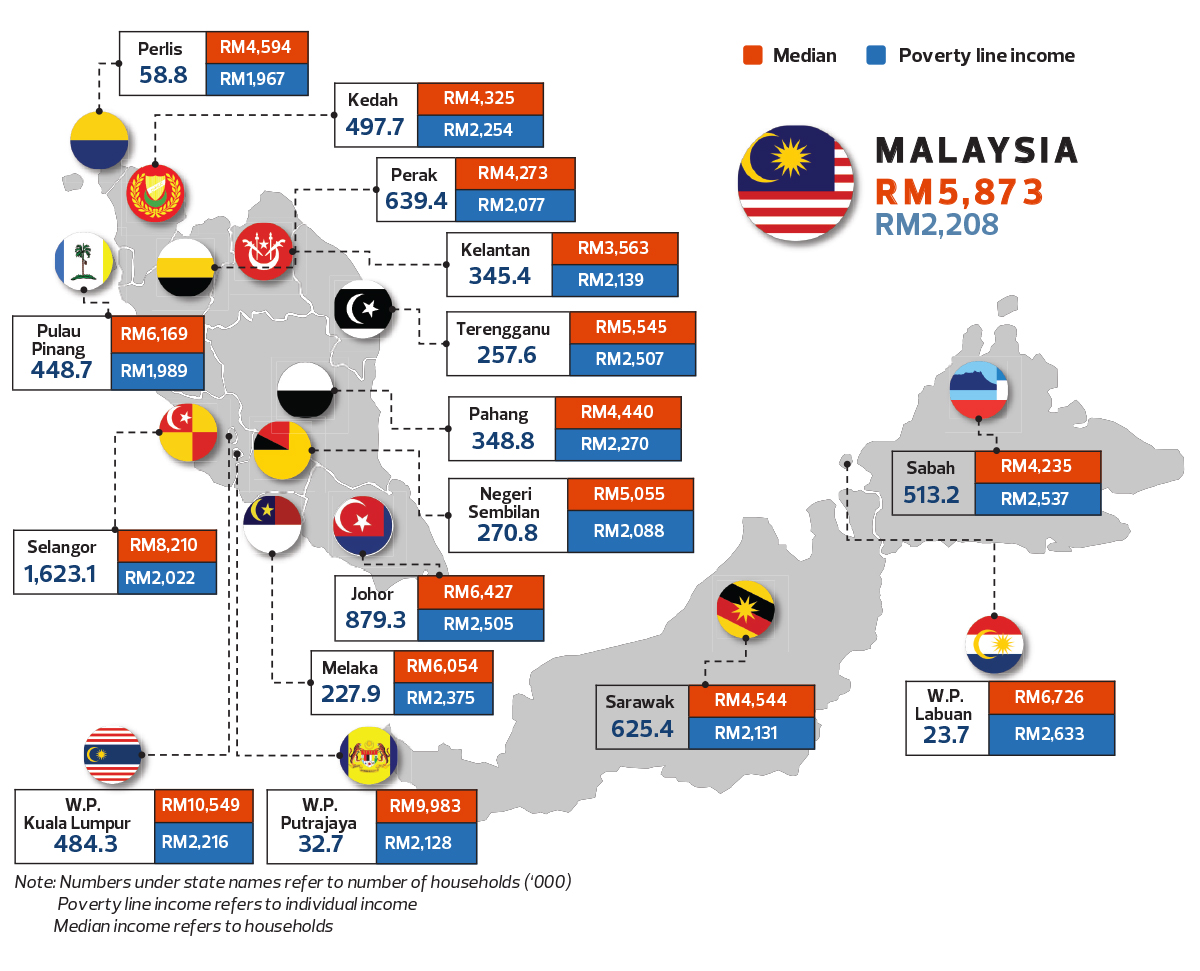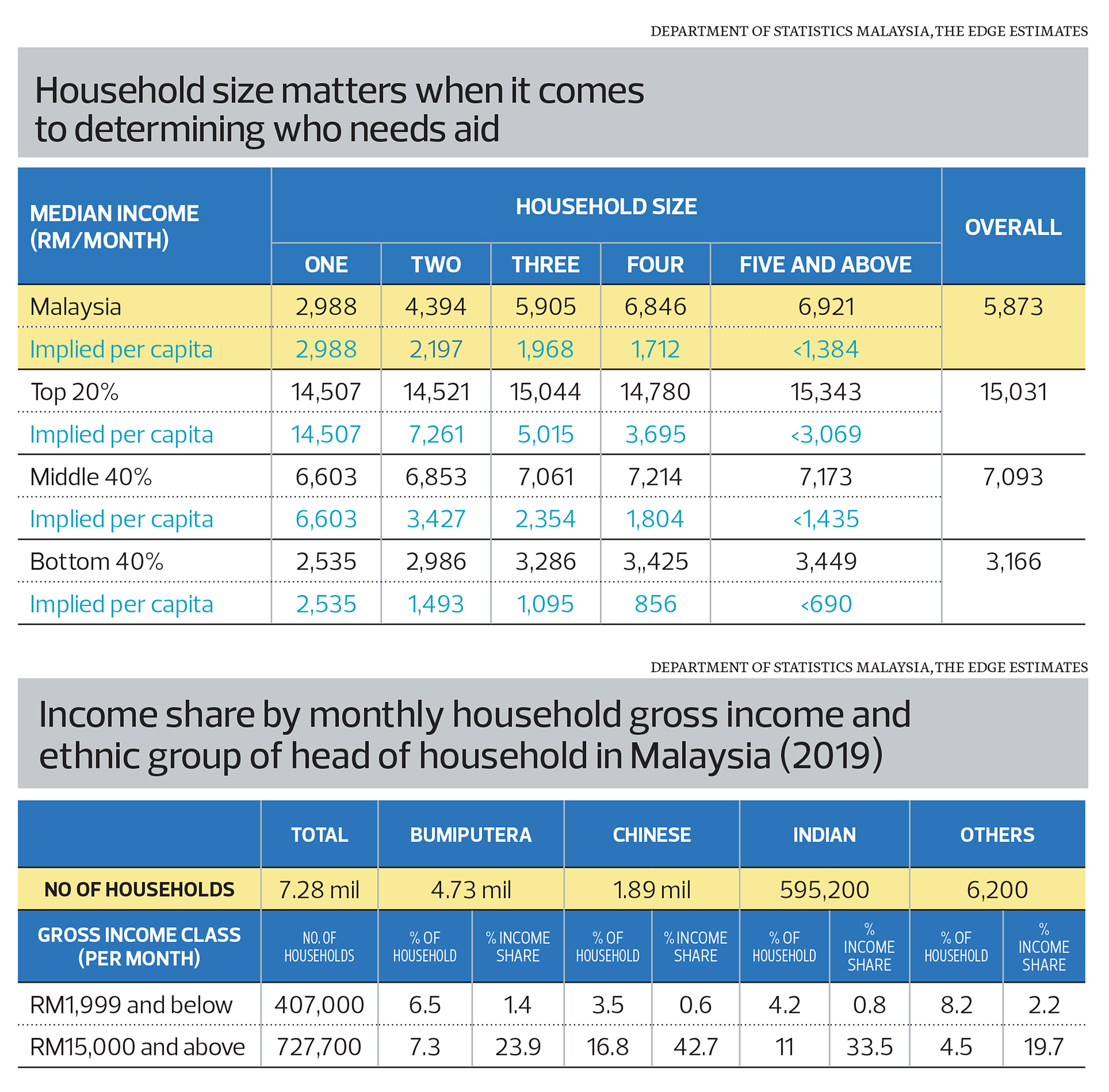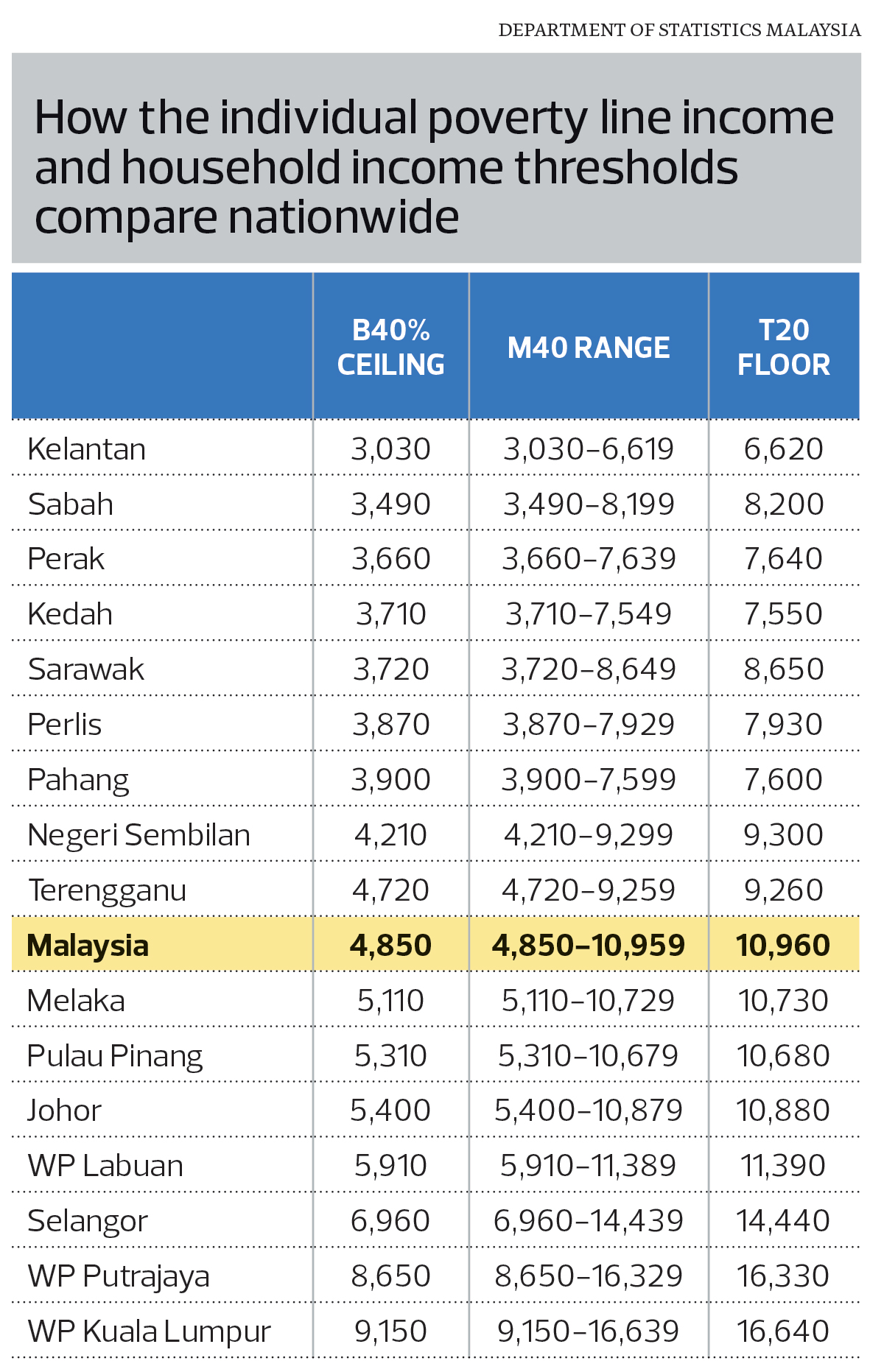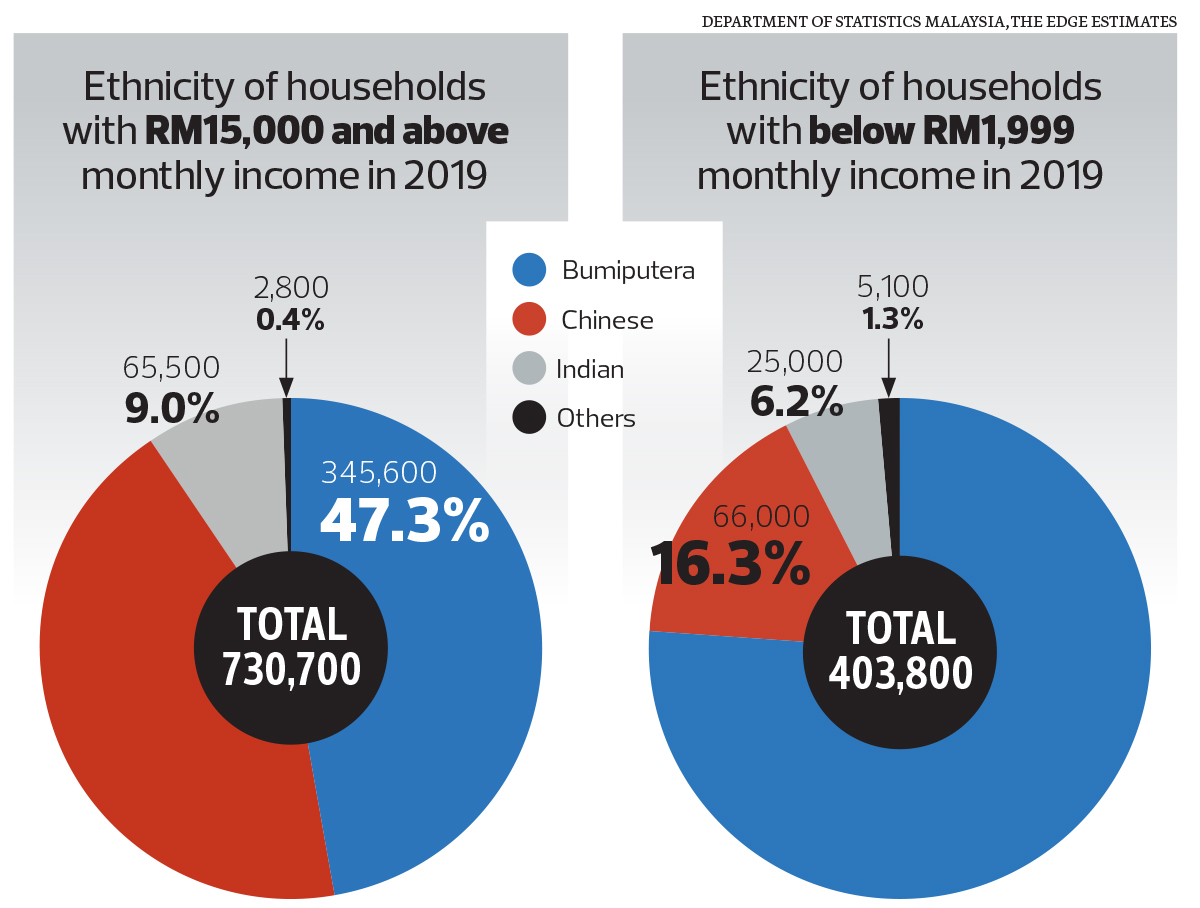
This article first appeared in The Edge Malaysia Weekly on July 20, 2020 - July 26, 2020
ALL Malaysians interested in the income discourse should read the 2019 Household Income and Basic Amenities Survey (HIS) and Household Expenditure Survey (HES) reports plus related figures released by the Department of Statistics Malaysia (DoSM) from July 10. If nothing else, the HIS recorded the state of income of 7.3 million Malaysian households before the impact of the Covid-19-related movement curbs hit the economy and livelihoods.
Apart from data to make more informed conclusions for policy research and planning, there is interesting information on housing-related expenses as well as anecdotes that may well confirm one’s suspicions about who does the most online shopping and consumes the most takeaway food in Malaysia.
According to DoSM, there were eight million households in Malaysia in 2019. The HIS, however, represents the 7.3 million Malaysian households (7.2767 million to be exact), 80% of whom are deemed urbanites.
Half of Malaysian households had a monthly income of at least RM5,873 in 2019 compared with RM5,228 in 2016 when the last HIS was done. DoSM data also shows that half of the bottom 10% of households earn less than RM1,929 a month. The median income is RM2,786 a month in households in the higher half of the bottom 20% of households (11 to 20 decile or 10%>x>20%).
In 2019, 33.6%, or 2.4 million households, had at least five people; followed by 21%, or 1.53 million, with four people; 19.3%, or 1.4 million, with three people; 18.4%, or 1.34 million, with two people; and 7.7%, or 559,800 single-person households.
Household size matters
The size of their need for government or third-party aid can vary significantly, depending on the size of household — a factor that a number of researchers have pointed out to be a necessary consideration in expanding the social safety net.
For example, the median income of a single-person household in the bottom 40% (B40) is RM2,535 — possibly decent even when stacked against the median income of RM7,214 in a middle 40% (M40) household with four members where per capita income is only RM1,804 (see table).
Similarly, the RM3,425 median income in a four-person B40 household works out to a per capita income of only RM856 a month. The per capita income falls to RM690 (at best) for the B40 household with at least five members whose median income was found to be RM3,449 in the survey, a back-of-the-envelope calculation shows.
When revising higher its poverty line income (PLI) from RM980 to RM2,208, Malaysia said there were 405,441 poor households in 2019. About 408,800 households probably earned below RM2,000 a month in 2019 compared with 357,700 households with at least RM20,000 a month, estimates by The Edge show.
Out of 405,441 poor households, 70.4% had at least five members while 13.3% had four, according to the HIS report, which noted that this situation “clearly explains that household size is one of the factors that influence poverty in Malaysia”.
The DoSM also noted that the populace aged 65 years and above recorded a poverty incidence of 12% in 2019, higher than 10.9% in 2016. This highlights the increasing need for more policy action for the aged. As it is, however, the HIS found the highest instances of poverty among poor households with a household head aged 45 to 49 at 16.3%, followed by 15.4% in those with household heads aged 40 to 44 and 13.1% in those between 50 and 54.
Rural populace can’t all be poor
According to the HIS, median household income of the urban populace rose 3.8% from RM5,860 in 2016 to RM6,561 in 2019, whereas that in the rural areas increased 3.3% from RM3,471 to RM3,828 over the same period.
If experts from the United Nations are right about the bottom 15% to 20% of the populace living in poverty, then urban poverty is a natural conclusion, given that the 20%, or 1.47 million households, living in the rural parts of Malaysia cannot all be poor. Kuala Lumpur and Putrajaya are deemed urban in the HIS.
About 31.1% rural households are in East Malaysia — 192,100 households in Sabah and 265,600 households in Sarawak. In the peninsula, the highest number of rural households are in Johor (12.1%, or 177,900 households) followed by Kelantan (11.2%, or 164,400), Kedah (9.1%, or 133,800), Pahang (8.9%, or 130,300 s), Perak (8.3%, or 121,600), Selangor (6%, or 88,600), Terengganu (5.5% or 81,000), Negeri Sembilan (4.4% or 65,300), Perlis (1.3% or 18,900), Pulau Pinang (1.2% or 17,100), Melaka (0.7% or 10,900) and Labuan (0.2% or 2,600).
Of the 1.47 million rural households in Malaysia, 88.3%, or 1.3 million, are bumiputeras, with the rest being Chinese (8.2%), Indian (2.2%) and others (1.2%).
The DoSM’s 2020 population estimate report does not provide a breakdown on strata (urban versus rural).
There is no breakdown for bumiputera Malays and non-Malay bumiputeras, a factor that the UN’s final report on poverty in Malaysia released on July 7 says obscures the situation of indigenous people.
Bumiputera 47.5%, Chinese 43.5% in top income tier
As individuals, the country’s 20.37 million bumiputera make up 69.3% of 29.38 million Malaysian citizens and 62.6% of the 32.52 million Malaysian population (including 3.14 million non-citizens of different nationals, who collectively exceed 2.01 million Indians).
Bumiputera households are the majority at 65.1% (4.73 million households), followed by Chinese at 25.9% (1.89 million households), Indians at 8.2% (595,200 households) and the rest at 0.9% (62,200 households).
Based on data released by the DoSM subsequent to the HIS, back-of-the-envelope calculations show bumiputera households account for the most households that earn up to RM1,999, with about 307,700 households — more than the roughly 66,000 Chinese households, 25,000 Indian households and 5,000 households whose heads of household are of other ethnicities.
Nonetheless, the highest number of households with income of at least RM15,000 are bumiputera, at about 345,600 households (47.5%), compared with about 316,800 Chinese households (43.5%), about 65,500 Indian households (9%) and 2,800 households whose heads of household are of other ethnicities.
The roughly 345,600 bumiputera households earning at least RM15,000 a month, which make up 7.3% of total bumiputera households, account for the 23.9% income share of the ethnic group. The roughly 65,500 Indian households with the same income range make up 11% of total Indian households and account for 33.5% of the income share of their ethnic group.
The disparity in the ethic group is greater at the roughly 316,800 Chinese households in the same income range that make up 16.8% of total Chinese households but account for 42.7% of income share of the ethnic group, according to DoSM data.
The HIS report offered little explanation on the income disparity within the different ethnic groups but touched on the gap between the average income of the different ethnic groups, describing the “wide economic gap between ethnics” as “one of the nation’s biggest challenges” and noted that “accurate and detailed information is needed to formulate policies and precise programmes”.
The provision of more granular data to independent researchers would help enrich the knowledge pool available for reference by policymakers faced with an uphill task of expanding the social safety net for the most vulnerable in society.
Save by subscribing to us for your print and/or digital copy.
P/S: The Edge is also available on Apple's App Store and Android's Google Play.
- MAG offers up to 30% off for Malaysian Airlines tickets at Matta Fair
- China open to talks if Trump shows respect, names point person
- Chinese President Xi accorded state welcome at Istana Negara
- Govt to apply diagnostics-related group payment system to basic insurance only, private healthcare model unaffected — HLIB Research
- Sapura Energy bags multiple contracts worth nearly RM100 mil
- China’s Xi says stands with Malaysia, region in countering unilateralism
- Malaysia-China foreign policies shaped by clear-eyed vision, Asean centrality — Anwar
- China remains Malaysia’s key partner as turbulence hits global trade, says Anwar
- Asean should accelerate economic integration efforts — Singapore PM
- Sarawak to consolidate assets amid global economic uncertainty — Abang Johari






